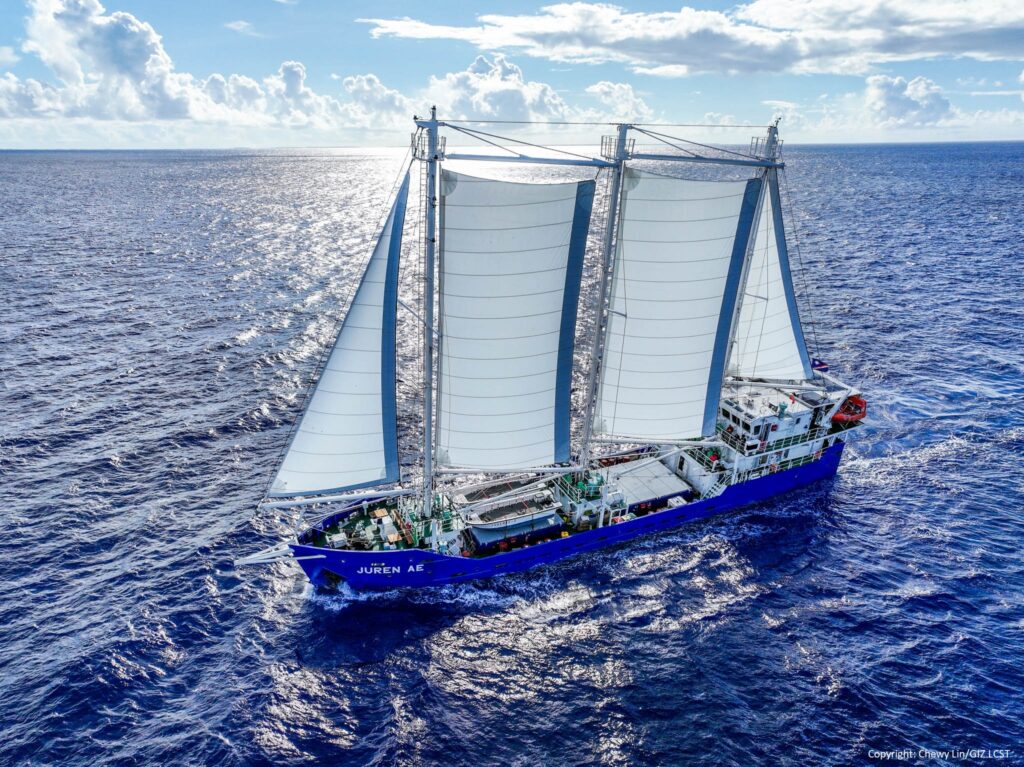
The Republic of the Marshall Islands (RMI) is deeply linked to sea transport. It is home to the world’s third largest shipping registry and the largest hub for tuna turnover. With over 1,000 islands, shipping is not just an economic sector – it is the lifeblood of the nation. The challenge: The RMI’s national shipping fleet depends heavily on imported fossil fuels, which contribute substantially to greenhouse gas emissions and air pollution. This reliance also imposes a significant financial strain on both national and household budgets.
With the pioneering cargo sailing vessel SV Juren Ae, the Republic of Marshall Islands sends a strong signal for a new era of low-emission cargo transport opportunities in the Pacific region and positions the RMI as a leader in climate action. The SV Juren Ae is the first modern low-carbon sailing cargo vessel in the Pacific, representing a transformative step toward a sustainable, energy-efficient future for the island nation and the whole region.
The boat features a partially automated sail system, inspired by traditional Indonesian designs, which is complemented by photovoltaic power units and a hybrid propulsion system. This allows the ship to transport cargo and people to and between the atolls of the Marshall Islands without relying on foreign combustible imports and emitting high levels of greenhouse gases. Designed to reduce CO₂ emissions by up to 80% compared to conventional vessels of similar size, it serves dual purposes: transporting essential goods between islands and atolls, and acting as a floating classroom to train the next generation of maritime professionals.
The Juren Ae is a beacon of possibility, urging other nations to embrace innovation, invest in clean technologies, and take bold action to safeguard the planet for generations to come.
Marshallese Transport Minister Hilton Kendall
The innovative vessel marks a key milestone of the Low Carbon Sea Transport (LCST) project, funded by the International Climate Initiative of the German government and implemented by the Deutsche Gesellschaft für internationale Zusammenarbeit (GIZ). One year ago, the innovative vessel sailed from South Korea to the Marshall Islands, to ignite a new era for low-carbon maritime transport in the Pacific. The journey was not only the SV Juren Ae’s maiden voyage but also a catalyst for extending the LCST project to promote sustainable shipping throughout the region.
In July 2024, the SV Juren Ae set sail from Geoje, South Korea, bound for Majuro in the Marshall Islands – a journey spanning over 6,500 kilometres. Onboard were project leader Raffael Held and a nine-member crew who spent four weeks navigating the wind, waves, and weather.
The extraordinary voyage was captured in a cinematic short film documentary, highlighting the challenges and triumphs of this long-range sailing experience. Since the vessel’s official handover to the Marshall Islands government, it has been in regular operation by the Marshall Island Shipping Corporation since September 2024. Cadets are now continuously trained onboard, and operational insights are shared with other Pacific Island states.
The project’s momentum has continuously gained traction since the vessel’s delivery. Earlier this year, delegations from the RMI Ministry of Transport, the Pohnpei State Legislature, and GIZ LCST convened in Busan, South Korea, for a high-level technical mission aimed at advancing low-emission maritime solutions for the Pacific region. The mission included in-depth discussions on the SV Juren Ae’s performance, maintenance, and design adaptations tailored for Pohnpei State. Joint shipyard surveys provided valuable insights into production capacity, customisation options, and delivery timelines. The collaboration builds on the recently signed Letter of Intent between RMI, Pohnpei, and GIZ, signalling a shift from national initiatives toward a regional model for sustainable maritime transport.
Since the arrival of the SV Juren Ae in the RMI, the LCST project has been extended with two new components: scaling up efforts across the Pacific and ensuring the sustainable continuation of the past eight years of work in the RMI. The project and especially the SV Juren Ae does not only facilitate business and improve inter-atoll transport for the Marshallese people – it also positions the RMI as a leader in climate action.
By demonstrating how a country can move the needle in the global ambitions to limit the global temperature rise to 1.5°C the RMI sets an inspiring example. In its official Nationally Determined Contribution (NDC) to the United Nations Framework Convention on Climate Change (UNFCCC), the RMI aims to reduce transportation emissions by 16% by 2025 and 27% by 2030.
The SV Juren Ae is more than just a ship – it is a symbol of hope and innovation for sustainable shipping in the Pacific. As the LCST project expands regionally, it paves the way for other island nations to embrace low-carbon maritime transport, while protecting the environment and supporting vital economic activities. The sails are set in the Pacific, and the winds of sustainability are carrying the region towards a brighter future.
The Low Carbon Sea Transport Project is based in the Republic of the Marshall Islands. It is funded through the International Climate Initiative (IKI) of the German Federal Ministry for the Environment, Nature Conservation, Nuclear Safety and Consumer Protection (BMUV).
 The SV Juren Ae on its journey towards a low-emission cargo future in the Pacific region. | ©Chewy Lin
The SV Juren Ae on its journey towards a low-emission cargo future in the Pacific region. | ©Chewy Lin

Marie Goss
marie.goss@giz.de
Visit profile